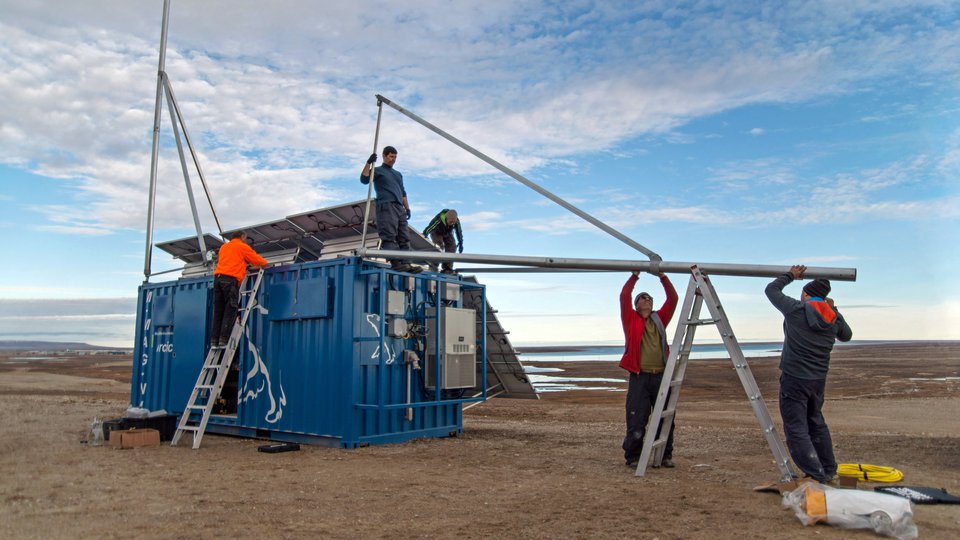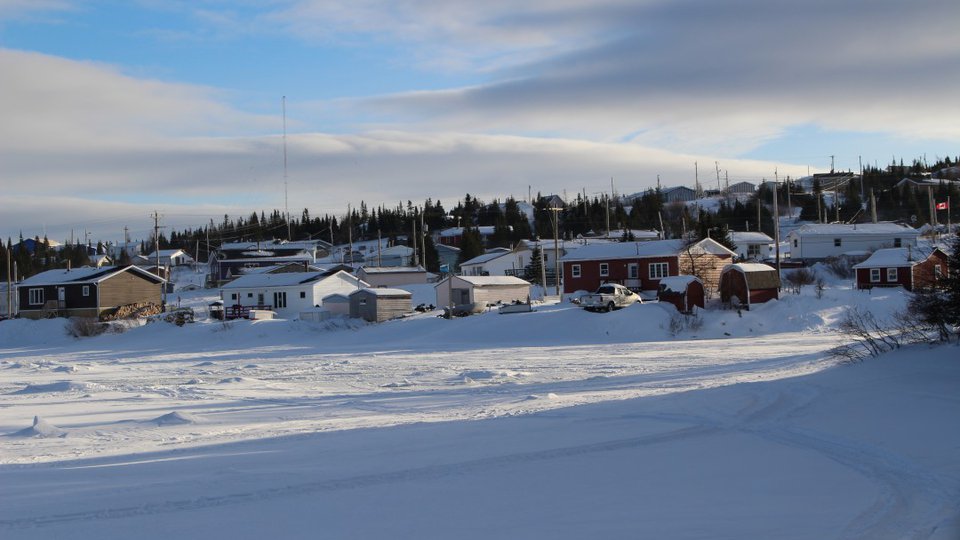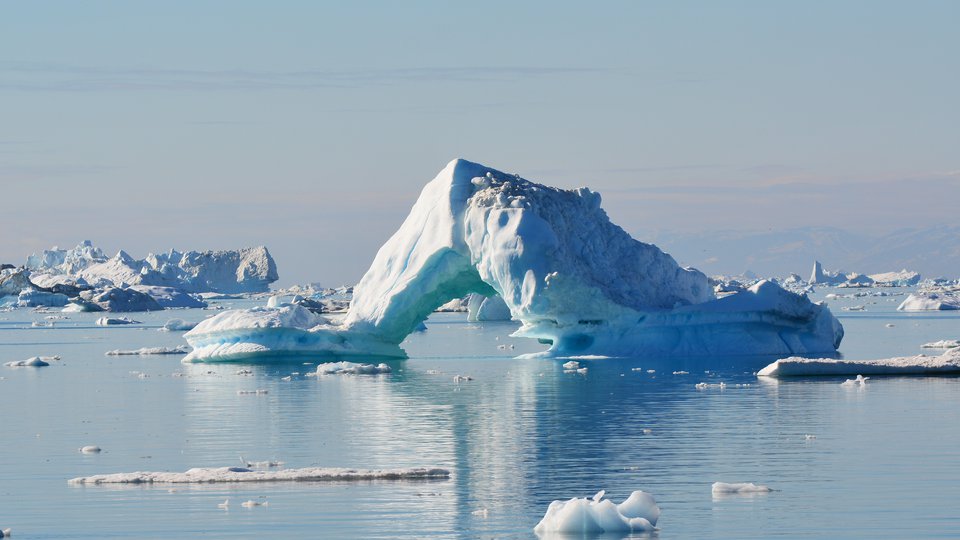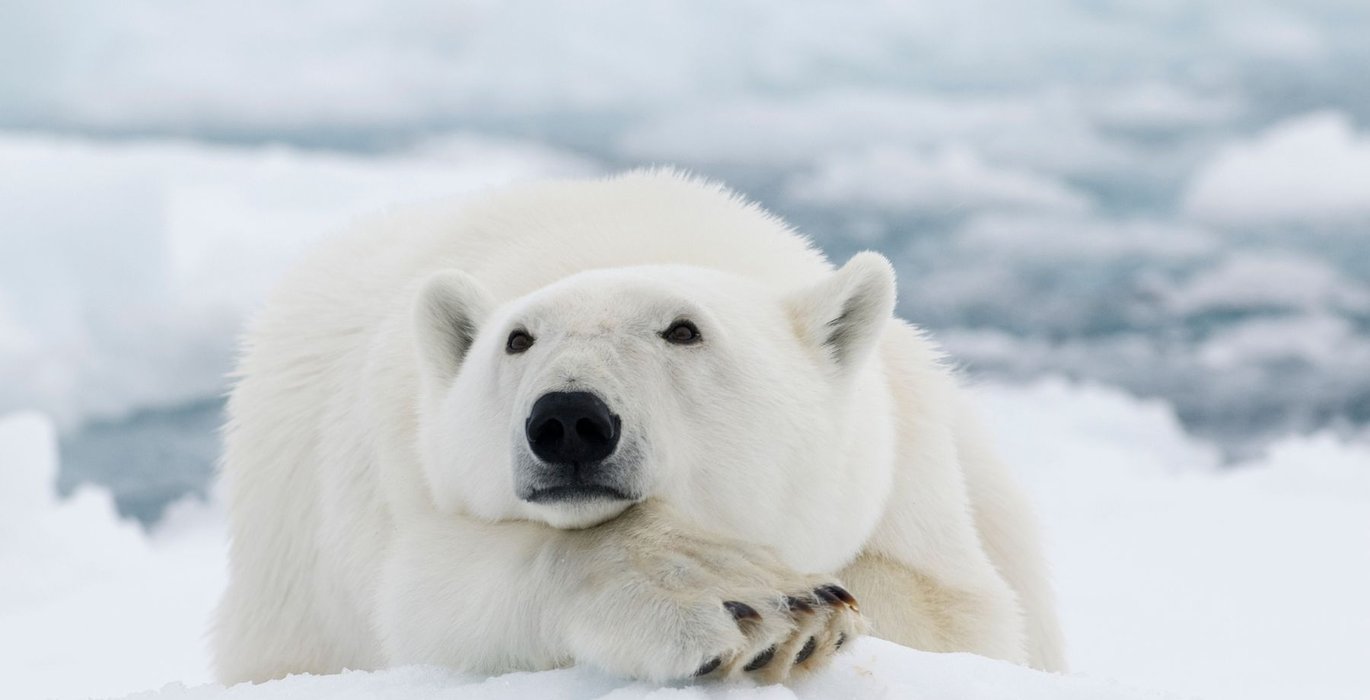
The Barents Sea is warming at a rate faster than any other Arctic region, causing significant challenges for the polar bear subpopulation that inhabits it. Warming ocean and air surface temperatures have caused the white Arctic ice cap to melt, exposing the darker ocean that exists beneath. Since white surfaces reflect the sun’s energy and dark surfaces absorb it, a positive feedback loop is created. Rather than reflecting between 50-90% of the sun’s energy, this exposed ocean now absorbs most of it instead (1-2). It is the opposite of what should be happening in the Arctic.
Twenty subpopulations of polar bears exist across the circumpolar Arctic. They are separated primarily based on their movements and tend to stay within the areas where they were raised. Polar bears exhibit distinct behaviours in different areas because Arctic sea ice operates in unique ways across space; thus, climate change is affecting each subpopulation uniquely (3).
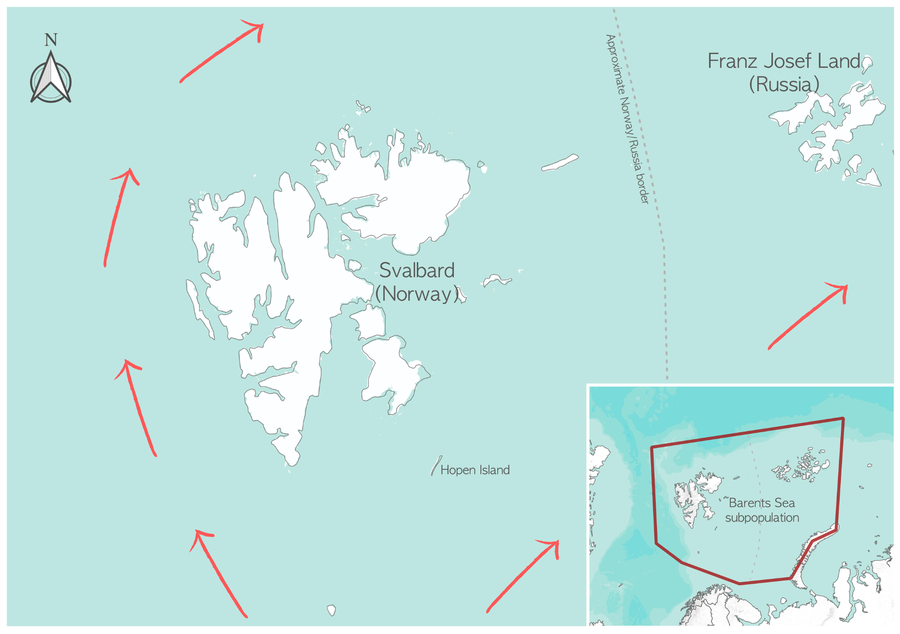
The Barents Sea subpopulation. The arrows indicate the path of the North Atlantic Current. Basemap: Esri; Boundaries: OpenDataSoft; Subpopulation: Government of Canada; Approximate current location is based on a map by the Norwegian Polar Institute. (Map Credit: Larissa Thelin)
North of Scandinavia and western Russia lies the Barents Sea subpopulation (BS) of polar bears, which is split between Norway (through Svalbard) and Russia. Polar bears here can travel great distances, often navigating expansive sea ice in search of food and mates (4). Unfortunately, they are losing this ice at a rapid rate (5). Sea ice is the platform that polar bears use to move throughout their world – as it melts, they lose the habitat they require to survive (6).
Changes in ocean currents are amplifying these effects. The Gulf Stream travels north from the equator along the eastern side of the Pacific, then crosses from east to west from North America to Europe, becoming the North Atlantic Current. Moving northwards, it ultimately brings a blast of warm waters to Svalbard’s southern coast (7). Due to climate change, the temperature of the Gulf Stream is increasing, resulting in it bringing even warmer temperatures to the Arctic (8). The combination of this and changes in the albedo effect (the measure of a surface’s reflectivity), along with shifting air currents (9), are exacerbating warming in the Svalbard area. They have caused the Barents Sea to lose over 40 days of sea ice every decade (5).
For BS polar bears, the reduction in hunting habitat due to sea ice loss creates a variety of challenges. Two types of polar bears exist there, each facing unique struggles (3). Pelagic polar bears utilize the sea ice throughout the year, but during the warmest months, this ice is pulled by ocean currents far north of the archipelago (4,10). Additionally, this ice is melting, causing the edge of the ice sheet to recede farther and farther north. As this continues, it may move away from the highly productive shallow waters of the continental shelf and pull bears over the deep, unproductive waters of the Arctic Basin, where they will struggle to find food (11).
Coastal bears, on the other hand, stay on shore during the warmest months and have adapted to largely fast during those months when the sea ice is gone (4,10). Unfortunately for these bears, the ice melts sooner and reforms later each year, forcing them to also struggle to find enough food (10).
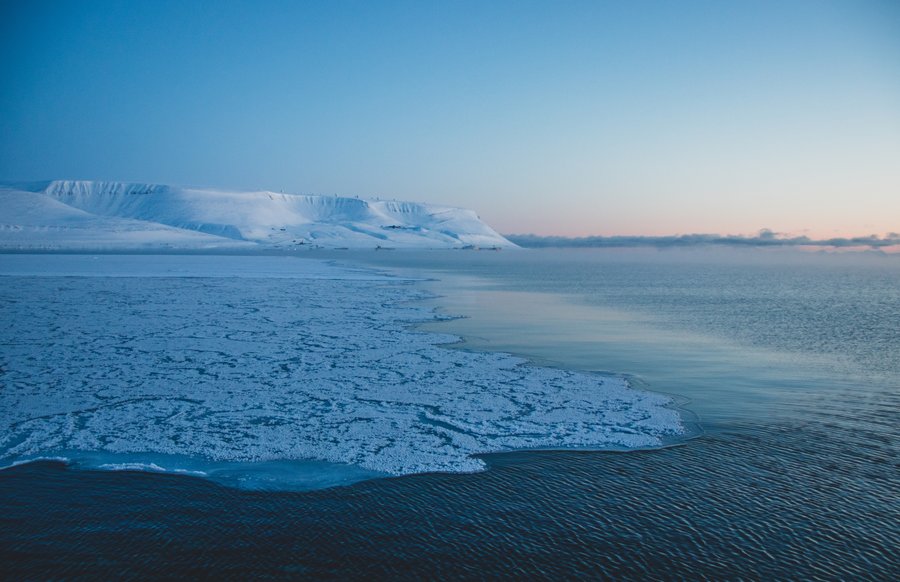
The Barents Sea to loses over 40 days of sea ice every decade. (Credit: Larissa Thelin)
However, polar bears are not the only Arctic marine mammal that requires sea ice for habitat. Their prey does as well. Arctic seals are a polar bear’s main prey. Compared to whales or walruses, seals are small enough for a polar bear to pull out of the water. They are also rich in fat, which polar bears require for their diet (12).
Both Arctic seal species (ringed seals and bearded seals), as well as other seals that can be found in the Arctic during parts of the year (e.g., harp seals and hooded seals), utilize the sea ice in some way. For all, sea ice is a platform to rest on during their long migrations, while searching for food, during their annual spring moult, or even when they give birth to their pups (13). The sea ice must remain expansive enough and of a specific thickness for these animals to use it in the manner for which they have evolved (13).
In the Barents Sea, ringed seals are an important prey for polar bears (14). These seals are even more dependent on sea ice than other species – rather than giving birth on top of the ice, ringed seals give birth within it, in small caverns they dig themselves called lairs (13). Using claws on their front fins, ringed seal moms dig through the ice into the layer of snow above to create a crucially safe space to raise their pups for the first six weeks of their lives (15).
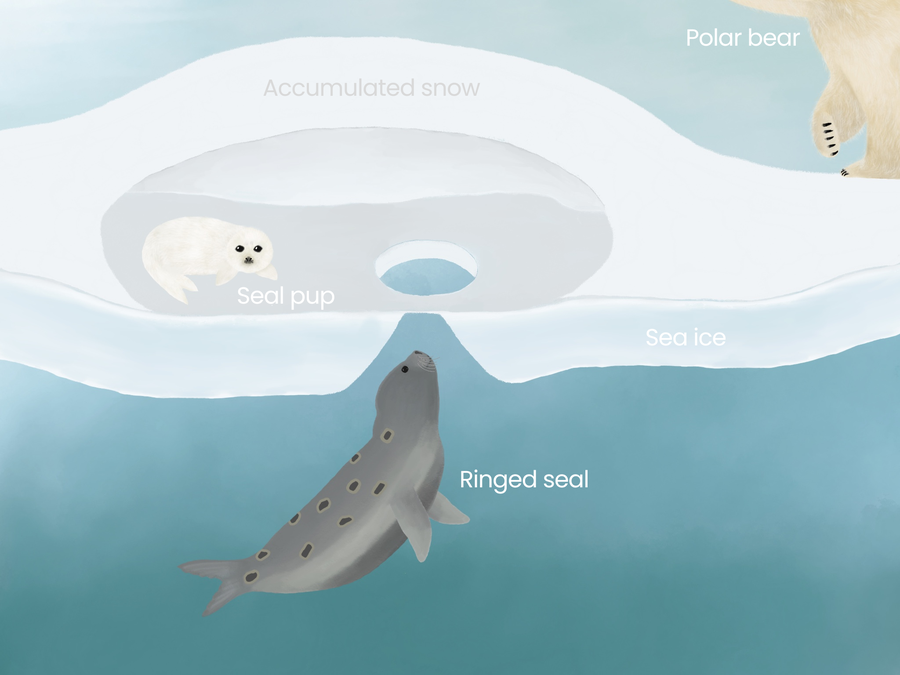
Ringed seal birthing lair (Illustration: Larissa Thelin).
Ringed seals born on top of the ice in some areas have a high mortality rate, due to exposure to extreme temperatures or predation (15-16). The ice and snow on top of it must therefore be thick enough for a ringed seal to successfully raise its young. As sea ice thins and as more snow falls as rain, the perfect habitat for reproduction is becoming increasingly difficult to find (13). Research suggests this seal habitat has been declining over the past few decades and may cease to exist in most of the region within the next decade (16). For BS polar bears, this means they are at risk of losing one of their most important sources of prey.
Furthermore, in some areas, sea ice serves as a platform that allows polar bears to access a specific part of their habitat, which is on land – their maternal denning areas. Female polar bears have den fidelity, which means they often return to the same denning areas where they were born (17). In the Barents Sea, polar bears dig their dens on the leeward side of tall mountain slopes, where snow has accumulated several meters thick (18-19). Female polar bears in this area have been forced to shift their denning behaviour within the span of a few decades (19-20), an incredibly difficult thing to do when that space used to provide the necessary cradle to raise generation after generation of polar bears.
For example, Hopen Island—a small Arctic island—was once a key denning site for polar bears in this subpopulation (20). Females could only reach it in late autumn by travelling over sea ice, which provided a safe route for denning. Without that ice, the swim is too long and dangerous. Due to the lack of sea ice in recent times, Hopen Island is no longer considered an important denning area (20).
Today, we do not know the exact number of polar bears within the BS. The last estimate occurred a decade ago (21), and updating these numbers requires extensive resources and collaboration between the two countries that house these bears. Even without these hurdles, it’s a difficult task to count moving creatures across a broad landscape. Instead, ecologists often turn to environmental variables to make their best assumptions – and for polar bears, as well as their prey, that’s the sea ice itself. With such rapid rates of ice loss for the bears in this part of the world, it’s safe to say that their health, and potentially their numbers, may very well be negatively impacted.
Fortunately for humanity and polar bears, it isn’t too late to act. The equation is simple. If we save the ice, we will save the bears.
Literature cited
- Thelin, L. 2025. The Global Importance of Arctic Sea Ice, and the Health of the Arctic Marine Food Web. Arctic Research Foundation. Retrieved from: https://www.arcticfocus.org/stories/global-importance-arctic-sea-ice-and-health-arctic/marine-food-web/
- National Snow and Ice Data Centre. n.d. Sea ice: Science. Retrieved from: https://nsidc.org/learn/parts-cryosphere/sea-ice/science-sea-ice
- Thelin, L. 2024. How geography plays a role in the different ways that polar bears are affected by climate change. Arctic Research Foundation. Retrieved from: https://www.arcticfocus.org/stories/how-geography-plays-role-different-ways-polar-bears-are-impacted-climate-change/
- Blanchet, M., Aars, J., Andersen, M., & Routti, H. 2020. Space-use strategy affects energy requirements in Barents Sea polar bears. Marine Ecology Progress Series, 639: 1-19. doi: 10.3354. Retrieved from: https://www.int-res.com/abstracts/meps/v639/p1-19/
- Stern, H.L. & Laidre, K.L. 2016. Sea ice indicators of polar bear habitat. The Crysophere, 10: 2027-2041. doi: 10.5194. Retrieved from: https://tc.copernicus.org/articles/10/2027/2016/
- Derocher, A.E., Lunn, N.J., & Stirling, I. 2004. Polar bears in a warming climate. Integrative and Comparative Biology, 44(2): 163-176. doi: 10.1093. Retrieved from: https://academic.oup.com/icb/article-abstract/44/2/163/674253?redirectedFrom=fulltext
- Norwegian Polar Institute. n.d. The Arctic system: The sea and ocean currents. Retrieved from: https://nettarkiv.npolar.no/www.arcticsystem.no/en/outsideworld/oceancurrents/index.html
- Isaksen, K., Nordli, Ø., Ivanov, B., et al. 2022. Exceptional warming over the Barents area. Nature, 12. Retrieved from: https://www.nature.com/articles/s41598-022-13568-5
- Efstathiou, E., Eldevik, T., Årthun, M., & Lind, S. 2022. Spatial patterns, mechanisms, and predictability of Barents Sea Ice Change. American Meteorological Society, 2961-2973. doi: 10.1175/JCLI-D-21-0044.1
- Polar Bears International. n.d. Barents Sea polar bears. Retrieved from: https://polarbearsinternational.org/what-we-do/research/barents-sea-polar-bear-population/
- Lone, K., Merkel, B., Lydersen, C., Kovacs, K.M., & Aars, J. 2018. Sea ice resource selection models for polar bears in the Barents Sea subpopulation. Ecography, 41: 567-578. doi: 10.1111/ecog.03020
- Polar Bears International. n.d. Diet & prey. Retrieved from: https://polarbearsinternational.org/polar-bears-changing-arctic/polar-bear-facts/diet-prey/
- Laidre, K.L. & Regehr, E.V. 2017. Arctic marine mammals and sea ice. Chapter 6 in Sea Ice (third edition). doi: 10.1002/9781118778371.ch21
- Derocher, A.E., Wiig, Ø, & Andersen, M. 2002. Diet composition of polar bears in Svalbard and the western Barents Sea. Polar Biology, 25: 448-452. doi: 10.1007/s00300-002-0364-0
- Norwegian Polar Institute. n.d. Ringed seal (Pusa hispida). Retrieved from: https://npolar.no/en/species/ringed-seal/
- Kovacs, K.M., Liston, G.E., Reinking, A.K., at al. 2024. Climate warming impacts on ringed seal breeding habitat in Svalbard. Ecological Modelling, 495. doi: 10.1016/j.ecolmodel.2024.110790
- Ramsay, M.A. & Stirling, I. 1990. Fidelity of female polar bears to winter-den sites. American Society of Mammologists, 71(2): 233-136. https://www.jstor.org/stable/1382172
- Togunov, R. 2020. The basics of polar bear denning. Polar Bears International. Retrieved from: https://polarbearsinternational.org/news-media/articles/polar-bear-denning-basics
- Norwegian Polar Institute. n.d. Where do polar bears den? Retrieved from: https://npolar.no/en/newsarticle/where-do-polar-bears-den/
- Derocher, A.E., Andersen, M., Wiig, Ø., et al. 2011. Sea ice and polar bear den ecology at Hopen Island, Svalbard. Marine Ecology Progress Series, 441: 273-279. doi: 10.3354/meps09406
- Aars, J., Marques, R.A. Lone, K., et al. 2017. The number and distribution of polar bears in the western Barents Sea. Polar Research, 36. doi: 10.1080/17518369.2017/1374125
